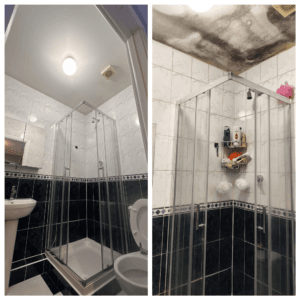What Causes Mould to Grow on Ceilings? Understanding the Root Causes
Mould on ceiling spores are ubiquitous, but they need certain conditions to grow: moisture, warmth, and organic material (such as drywall or paint). Ceilings are prime real estate because they’re often missed during kitchen and bathroom cleanings and are vulnerable to hidden moisture sources.
Let’s take a look at some of the biggest offenders:
Moisture Leaks
Roof Leak
Even a small crack on your roof tile or damaged flash can let rain enter your attic or ceiling cavities. This gradually creates a damp environment in which mould thrives.
Plumbing Leaks
Your pipes might leak—if you have pipes above the ceiling (in bathrooms or kitchens, for instance), they’ll frequently become woefully disrepaired until the mould shows up.
Condensation
In high-humidity rooms (e.g., bathrooms, laundry rooms), steam rises and condenses on cooler ceiling surfaces.
Poor Ventilation
Stagnant air traps humidity. Bathrooms that lack exhaust fans, kitchens that lack range hoods, or blocked air vents in homes create moisture pockets that are ideal for mould growth.
High Humidity Climates
In coastal areas or places with persistent rainfall, it is not unusual for indoor humidity to exceed 60%, the ideal humidity range for mould growth.
Post-Flooding Damage
Residual moisture in ceiling upholstery after floods or major leaks can create colonies of mould that feed within 24–48 hours if they remain wet and undried.
Ceiling Mould: Not Just a Source of Annoyance but Health Risks As Well
Mould isn’t simply unsightly—it’s a stealthy invader that can be detrimental to your health. Some types of mould are riskier than others:
Allergenic Moulds
Examples: Cladosporium, Alternaria
- It can cause sneezing, itchy eyes, and skin rashes.
Pathogenic Moulds
Examples: Aspergillus
- May aggravate asthma or cause lung infections in immunocompromised patients.
Toxic Moulds
Examples: Stachybotrys chartarum (black mould)
- Generates mycotoxins associated with chronic fatigue, headaches, and neurological problems.
High-Risk Groups
- Children, older adults, and individuals with respiratory conditions.
- Long-term exposure can cause hypersensitive pneumonitis or even irreversible lung damage.
How to Minimise the Risk of Mould on Ceilings
It is cheaper and easier to prevent mould growth than to remove it. Here’s how:
Eliminate Moisture Sources
Repair Leaks Promptly
- Have roofs inspected annually and patch cracked tiles or seal gaps around chimneys or vent pipes.
Upgrade Plumbing
- Use leak-detection devices or smart water shutoff systems to catch pipe leaks early.
Insulate Cold Spots
- Insulate metal pipes and outside walls to prevent condensation.
Boost Ventilation
Install Exhaust Fans
- Place in bathrooms and kitchens, ensuring they vent to the outside (not into the attic).
Open Windows Daily
- Even 15 minutes of cross-ventilation can help lower humidity.
Use Outdoor Ceiling Fans
- Maintain air flow to reduce stagnant and moist areas.
Control Indoor Humidity
Keep Humidity Between 30–50%
- Use dehumidifiers and hygrometers to monitor levels.
Air Conditioning
- AC units naturally dehumidify while cooling.
Moisture-Absorbing Plants
- Add peace lilies or Boston ferns to humid areas but avoid overwatering.
Select Mould-Resistant Products
Paint
- Use mould-inhibiting primers and paints (e.g., Zinsser Perma-White) in high-risk areas.
Drywall
- Install moisture-resistant “green board” in bathrooms and basements.
Insulation
- Spray foam insulation produces far less condensation than fibreglass.
Regular Maintenance
- Wash bathroom ceilings monthly with a vinegar-water solution.
- Inspect attics and crawl spaces for leaks or ventilation problems every three months.
How to Remove Ceiling Mould — Step-by-Step Guide
Safety First
- Wear an N95 mask, gloves, and goggles.
- Drape plastic sheeting to seal off the area and contain spores.
DIY for Small Patches (<10 sq. ft)
White Vinegar
- Pour pure white vinegar into a spray bottle.
- Saturate the mouldy area and wait for 1 hour before cleaning.
- Scrub with a stiff brush, then wipe with water until clean.
Why It Works: The acidity of vinegar kills 82% of mould species and prevents regrowth.
Baking Soda Paste
- Mix 1 part baking soda with 3 parts water to create a paste.
- Apply, scrub, and rinse.
- Forms a protective alkaline coating.
Hydrogen Peroxide (3%)
- Spray, wait 10 minutes, scrub, and rinse.
- Less harsh than bleach.
Avoid Bleach
- Bleach removes surface stains but does not kill mould roots.
- Emits harmful fumes.
Repairing Damaged Ceilings
For Small Holes
- Remove the affected drywall, treat with Concrobium, and patch with new drywall.
For Serious Damage
- Replace insulation or ceiling panels if mould has grown deep into materials.
Post-Cleaning Tips
- Use fans or dehumidifiers to dry the area thoroughly.
- Apply mould-resistant paint to create a protective barrier.
When to Call a Professional
DIY is not always safe or effective. Contact a mould remediation expert if:
- The impacted area is over 10 square feet.
- Mould is present in your HVAC system (risk of spreading spores).
- You suspect toxic black mould (slimy with a strong musty smell).
What to Expect from Professional Mould Removal
- Use of HEPA vacuums, antimicrobial treatments, and containment chambers.
- Prices vary based on the severity of the infestation.
Long-Term Mould Prevention Strategies
Monitor Humidity
- Use smart sensors like Govee or ThermoPro to track moisture levels.
Upgrade Ventilation
- Consider whole-home airflow systems such as Energy Recovery Ventilators (ERVs).
Landscaping Fixes
- Position gutters to direct water away from your home’s foundation.
FAQ: Your Common Mould Questions Answered
Q: Can I paint over mould?
A: No. Mould will continue to grow underneath the paint. Always clean and treat the area first.
Q: How soon does mould develop after a leak?
A: In warm, humid conditions, mould can develop within 24–48 hours.
Q: Does sunlight kill mould?
A: UV light can help, but it does not penetrate porous materials. Focus on moisture control.
Q: Is mould on the ceiling the landlord’s responsibility?
A: In most states, yes, if caused by unresolved leaks or structural issues.
Conclusion: A Healthy Home Is a Mould-Free Home
Ceiling mould is a symptom of excess moisture. With regular maintenance, ventilation, and prompt repairs, you can protect your home and family. For stubborn cases, seek professional help.
Prevention is not a one-time effort—it’s an ongoing habit that ensures clean air and peace of mind.


